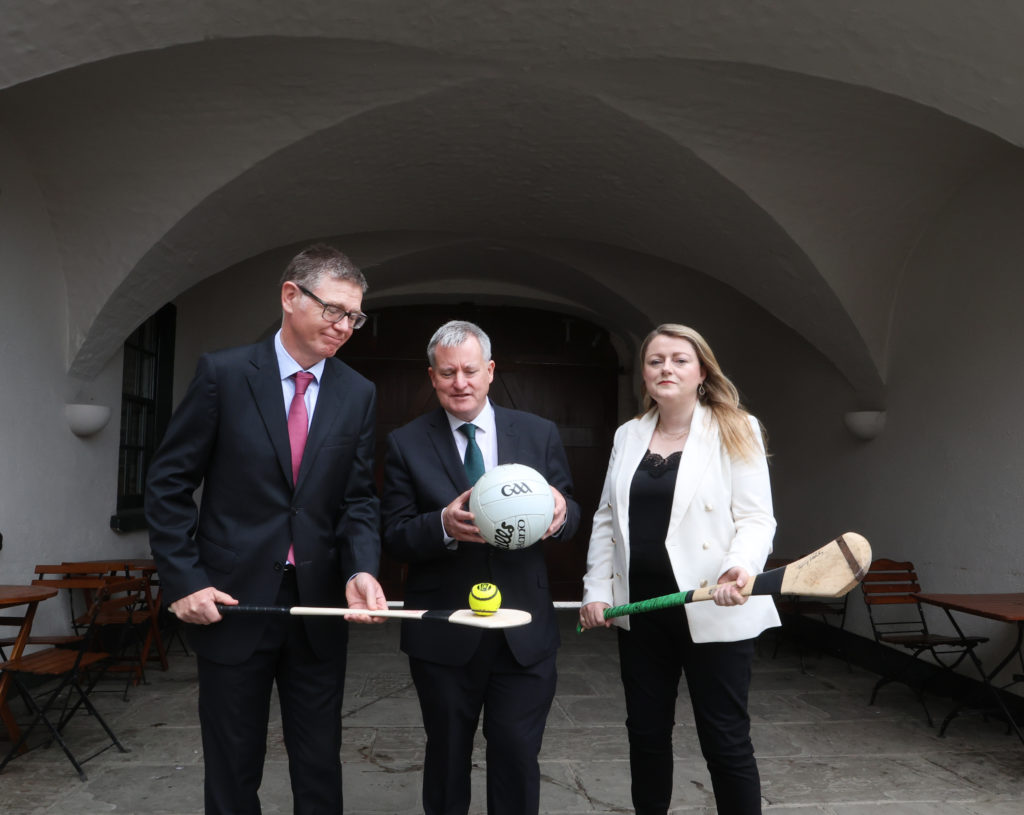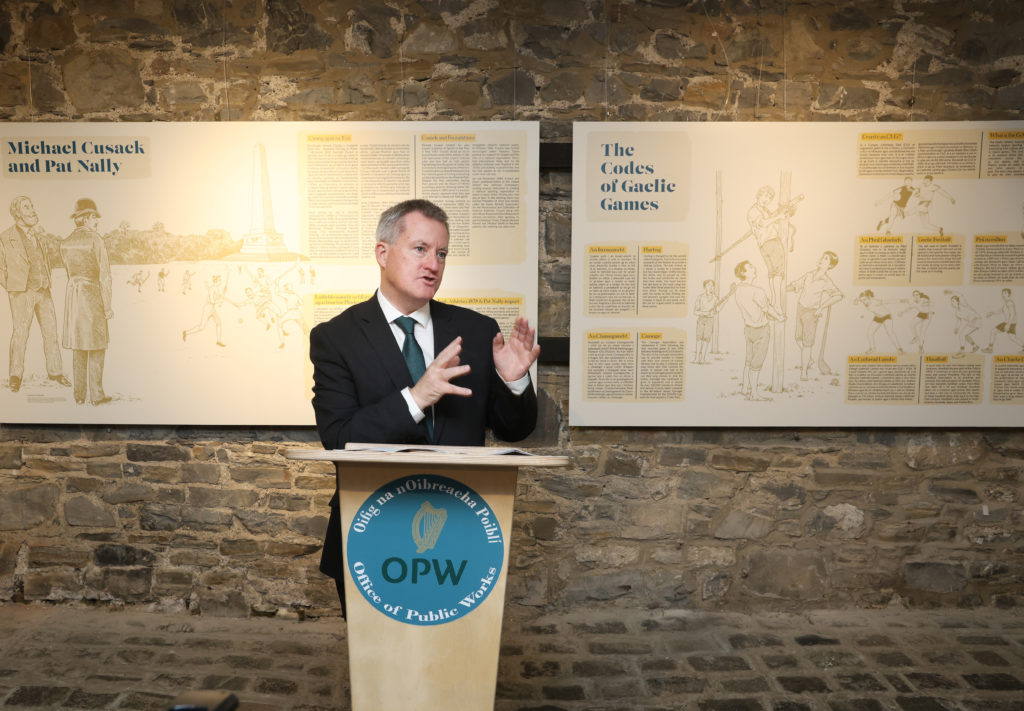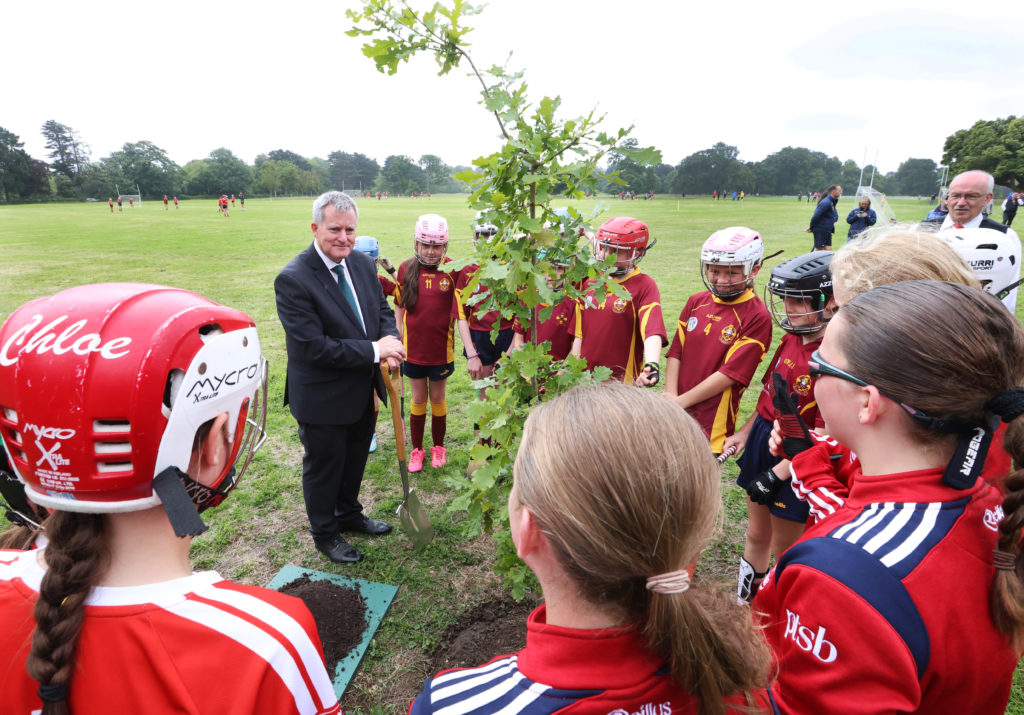A NEW exhibition has been launched which honours the important historic connections of Dublin’s Phoenix Park to the sporting lives of the people of Ireland.
Clann of Gaelic Games is a collaborative exhibition between the GAA Museum at Croke Park and Ireland’s Office of Public Works (OPW) which showcases centuries of hurling, camogie and football activity at the park.
Launched yesterday, to mark the 130-year anniversary of the playing of the GAA All-Ireland finals in the park’s grounds, the installation at the Phoenix Park Visitor Centre traces the history of Irish sports at the site.
 GAA Ard Stiúrthóir Tom Ryan GAA, OPW Minister of State Kieran O’ Donnell and Rosemary Collier, Head of Heritage Services and Capital Works Delivery at the OPW
GAA Ard Stiúrthóir Tom Ryan GAA, OPW Minister of State Kieran O’ Donnell and Rosemary Collier, Head of Heritage Services and Capital Works Delivery at the OPWMichael Cusack was inspired to found the GAA on November 1, 1884, following his efforts over the previous year trying to revive an interest in hurling through training sessions and exhibition matches held in the Phoenix Park.
As far back as the 1700s, hurling has been played in the Park, with teams having once competed on the land of the Vice Regal lodge, now Áras an Uachtaráin.
After the establishment of the GAA, the first ever inter-county match took place in the Phoenix Park in 1886 between Tipperary and Galway in hurling – the success of which is credited with encouraging the establishment of the All-Ireland senior championships the following year.
The All-Ireland Championship finals of 1893, which were not played until June 1894, were played in the Phoenix Park, with Blackrock of Cork winning in hurling against Confederation of Kilkenny and Young Irelands of Wexford crowned football champions after a final against Cork’s Dromtarriffe.
While the Park has played an important role in the sporting history of a range of sports for the last 140 years, it has continued to be significant to the playing of hurling and football for clubs and schools in Dublin.
 Kieran O’ Donnell, Minister of State with Responsibility for the Office of Public Works, speaks at the launch event
Kieran O’ Donnell, Minister of State with Responsibility for the Office of Public Works, speaks at the launch eventThis is equally so for the Camogie Association, which celebrates its 120th anniversary this year and has a long history of Phoenix Park activity.
The Park is also of crucial importance to the Ladies Gaelic Football Association, which marks its 50th anniversary this year.
Kieran O’Donnell TD, Minister of State with OPW responsibility attended the launch of the Clann of Gaelic Games exhibition, which will be open at the visitor centre for the next two months.
“The OPW is delighted to collaborate with the GAA in bringing this wonderful exhibition ‘Clann of Gaelic Games’ to the Phoenix Park which recognizes the importance of the Phoenix Park with the creation and the development of the GAA movement,” Minister O’Donnell said.
“This showcases another aspect of how the Phoenix Park has played an essential part in the lives of the people of Ireland throughout the years.”
He added: “I would encourage GAA enthusiasts and anyone with an interest in Gaelic games, the Phoenix Park and its history to visit this exhibit over the summer.”
GAA Director General, Tom Ryan said the Phoenix Park is “pivotal” in the story of the GAA in Ireland.
“You cannot tell the story of the GAA without talking about the Phoenix Park, such was the pivotal role it played in the years before the GAA’s foundation, and in its formative years,” Mr Ryan said.
 Minister O’Donnell planted a tree in the Phoenix Park in the Visitors Centre grounds
Minister O’Donnell planted a tree in the Phoenix Park in the Visitors Centre grounds“The Park’s links to Gaelic games go back much further and so it is fitting that in remembering the heroes of the 1893 All-Ireland finals, played in the Park, that we also commemorate the role the Park has played for several centuries facilitating Gaelic games and the importance it continues to have as a venue for football, ladies football, camogie and hurling," he added.
During the launch event, a plaque marking the 1893 finals was unveiled while an oak tree was planted by Minister O’Donnell to symbolise the strength of the link between Gaelic games and the Park.
Children from St Brigids and St Oliver Plunkett’s GAA clubs played exhibition games in football, hurling and camogie and GAA Games For All during the event.
Representatives from clubs and counties who competed in the 1893 All-Ireland finals were also in attendance.


